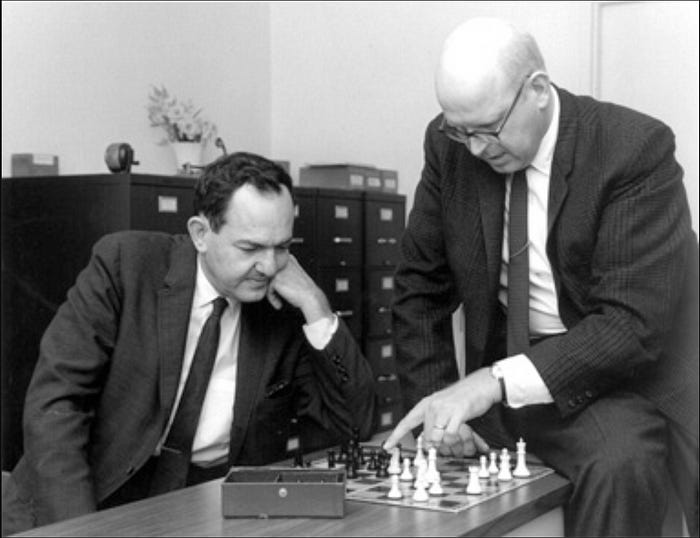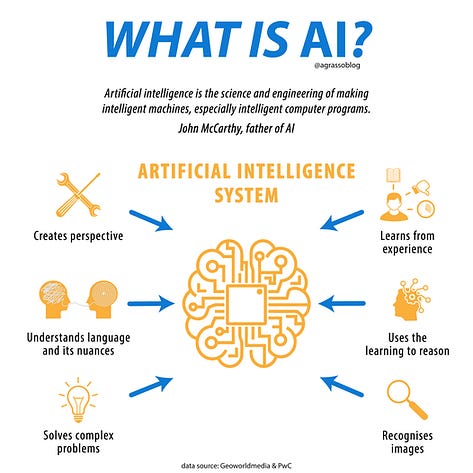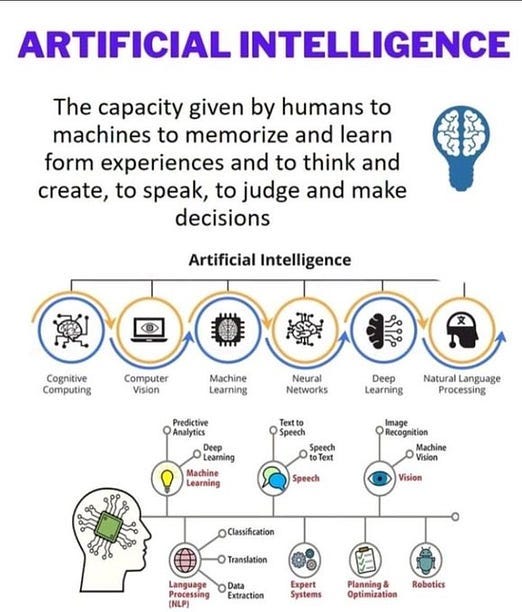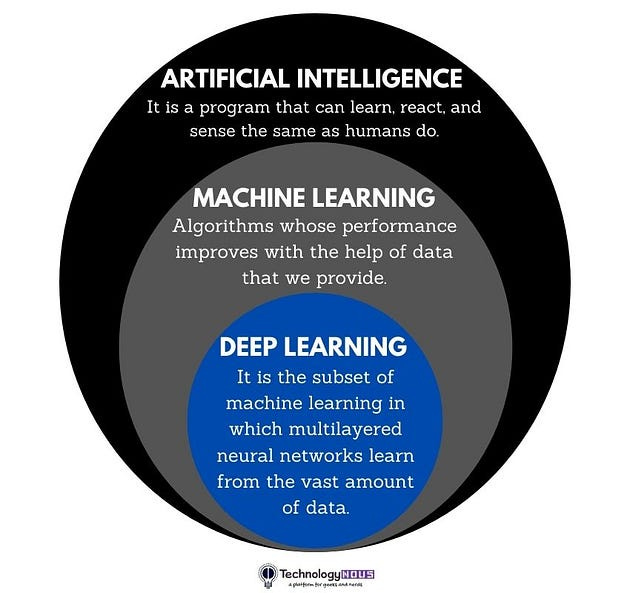Artificial Intelligence (AI) has transformed from a visionary concept into an indispensable technology reshaping our world. From its philosophical roots and early computations to modern machine learning breakthroughs, AI now powers everyday tools—voice assistants, recommendation systems, and cutting-edge healthcare diagnostics. In this post, we’ll explore why humans created AI, trace its evolution from symbolic logic to neural networks, clarify what AI truly means today, and showcase real-world applications driving innovation across industries.
📚Chapter 1: Introduction to Machine Learning
If you want to read more articles about Machine Learning, don’t forget to stay tuned :) click here.
Section
Why we used AI
History of Artificial intelligence
Natural Intelligence (NI)
What is Artificial intelligence (AI)
Section 1 — Why we used AI
In traditional programming, when aiming to implement new functionalities or automate tasks, software development is typically required. This involves writing code containing a predetermined set of instructions, such as if-then-else statements, to direct the computer’s actions. Consequently, to accomplish a variety of tasks, a corresponding number of rules must be provided to the computer, posing a significant challenge. This limitation highlights that conventional programming approaches lack generalizability.
if you haven’t done it by yourself, requires laying out in excruciating detail every single step that you want the computer to do in order to achieve your goal. Now, if you want to do something that you don’t know how to do, then this is going to be a great challenge. Basically, regular programming is pretty limited and can’t make decisions on its own. That’s why we need generalized programming, which is more than just a programmer and can make decisions from our perspective.
So, basically, this Arthur Samuel had a challenge in 1956. He wanted to teach a computer to beat him at checkers. Like, how do you even do that? Well, he came up with a plan. He had the computer play against itself over and over again, like thousands of times, until it learned how to play checkers really well. And guess what? It actually worked! By 1962, the computer had even beaten the Connecticut state champion. Pretty impressive, right?
Section 2- History of Artificial intelligence
Even though artificial intelligence, or AI, has only been around for less than a hundred years, the idea of machines that can think goes way back. Even in ancient Greece, people were talking about intelligent robots and artificial beings. The whole idea of AI really starts with asking if machines can think like humans
1955
In 1955, Allen Newell and Herbert A. Simon made the first computer program meant to act like a smart thinker. They called it the “Logic Theorist.” This program tried to prove math ideas using logic symbols. It used a special way of searching for answers that imitated how humans solve problems. [7]. The Logic Theorist was like the first computer tool that could solve lots of different problems, not just one. It was a big deal in the world of smart computer programs. [7].
Alan Turing, was an eminent mathematician, who is famous for breaking the Nazi Enigma code during World War II. This code gave the Allied Powers the edge they needed to win the war — it also laid the foundation for the creation of the computer.
1956
It was the year when the term “Artificial Intelligence” was first coined as an academic field by American computer scientist John McCarthy at the Dartmouth Conference. This conference was attended by some of the leading researchers in the field of AI, including Marvin Minsky, Claude Shannon, and Nathaniel Rochester [7].
At the conference, McCarthy gave a talk titled “The Limitations of and Prospects for Information Processing in Problem-Solving Machines.” In this talk, he proposed the creation of a new field of study called “Artificial Intelligence” that would focus on developing intelligent machines [7]
Dartmouth scientist, John McCarthy, expanded on Turing’s ideas and coined the term “artificial intelligence” in 1955. McCarthy assembled a team of computer scientists and mathematicians to investigate if robots could learn the same way that children do, through trial and error, to build formal reasoning. The team hoped to ascertain how they could make machines “use language, form abstractions and concepts, solve [the] kinds of problems now reserved for humans, and improve themselves.” [4]
Let me explain the history of AI. First, Alan Turing, a founding father of AI, came up with the question that “Can machines think like humans?”. Later, John McCarthy created the term “Artificial Intelligence” and invented the programming language LISP, played computer chess via the telegraph with opponents in Russia, and invented computer time-sharing. At that time, the computer was big enough to fill a room. But the concept of AI has created great hope and enthusiasm for the world of science and technology [3].
In recent years, AI has focused on tasks that only humans can do, such as image and voice recognition. Thus, the following problems that were previously unsolvable were now overcome with AI [3].
Image recognition
Object recognition
Language-to-language translations
Natural language comprehension
Image and speech recognition
Assistant assistants
Driverless cars
While AI was seen in the 60s and 70s as a computer skill that could play chess and checkers, perform simple calculations, and solve mathematical problems, in the 80s and 90s it was seen as a risk assessment and decision-making ability, and in the 2000s, with the development of the computational potential of computers, it was understood that learning systems could be possible [3]
Thought: Facebook uses an artificial neural network for facial recognition
Speech and Hearing: Google Assistant, Siri
Vision: Capturing Traffic Violations
Section 3- Natural Intelligence (NI)
Def: NI is the intelligence naturally evolved in living beings in response to the level of complexity in problems, challenges etc
Def: Natural intelligence (NI) is the inherent ability of living organisms to adapt to and interact with their environment. It encompasses a wide range of cognitive capabilities, including learning, problem-solving, reasoning, and communication.
Helps in “ What to do, When we do not know”
Humans, animals, birds etc
Thought, Vision, Speech, Hear, Feel
4- What is Artificial intelligence (AI)
There are many definitions and versions of Artificial Intelligence, WHICH IS GENUINE, TRUE AND REAL.
Def: Artificial Intelligence (AI) refers to the simulation of human intelligence in machines that are programmed to think like humans and mimic their actions. The term may also be applied to any machine that exhibits traits associated with a human mind such as learning and problem-solving.
Def: AI is a technology that allows machines to simulate human behavior. It is a field of computer science that allows machines to execute complex tasks such as image recognition, decision making, and conversing [4].
Def: The term Artificial intelligence (AI) was first coined a decade ago in the year 1956 by John McCarthy at the Dartmouth conference. He defined “Artificial intelligence as the science and engineering of making intelligent machines”. In a sense, artificial intelligence is a technique of getting a machine to work and behave like humans. AI works best by combining a large number of data sets with fast, repetitive, and intelligent algorithms.
IBM
Def: Artificial intelligence leverages computers and machines to mimic the problem-solving and decision-making capabilities of the human mind.
Oracle
Def: Artificial Intelligence refers to systems or machines that mimic human intelligence to perform tasks and can iteratively improve themselves based on the information they collect.
Accenture
Def: Artificial intelligence is a constellation of many different technologies working together to enable machines to sense, comprehend, act, and learn with human-like levels of intelligence
SAS
Def: Artificial intelligence (AI) makes it possible for machines to learn from experience, adjust to new inputs and perform human-like tasks.
Encyclopedia Britannica
Def: Artificial Intelligence is the ability of a digital computer or computer-controlled robot to perform tasks commonly associated with intelligent beings.
Stanford University
Def: Artificial Intelligence is the science and engineering of making intelligent machines, especially intelligent computer programs.
Amazon AWS
Def: Artificial Intelligence is the field of computer science dedicated to solving cognitive problems commonly associated with human intelligence, such as learning, problem solving, and pattern recognition.
European Parliament
Def: AI is the ability of a machine to display human-like capabilities such as reasoning, learning, planning and creativity.
Qualcomm
Def :AI is an umbrella term representing a range of techniques that allow machines to mimic or exceed human intelligence.
Def: This allows AI software to automatically learn from patterns or symbols in those big data sets.
Def: AI is the simulation of human intelligence by machines. It enables the machine to think like a human.
Background: It is a program that can learn, reach and sense the same as humans do or Similar to the intelligence humans possess, artificial intelligence is the one donned by machines. The only difference remains the absence of emotionality and consciousness. The Capacity is given by humans to machines to memorize and learn from experience and to think and create, to speak, to judge, and make decisions. The brain is the most wonderful organ of the human body. The brain controls thought, memory, emotion, motor skills, vision, breathing, and touch. This complex structure of the brain became a source of inspiration for scientists and the concept of AI emerged. AI is the ability of a computer or robot to perform humanoid tasks [3].
Let’s connect: If you found this helpful, share your thoughts or questions in the comments! 😊
🎯 Call to Action (CTA)
Ready to take your NLP skills to the next level?
✅ Enroll in our Full Course Machine Learning for an in-depth learning experience. (Note: If the link doesn't work, please create an account first and then click the link again.)
📬 Subscribe to our newsletter for weekly ML/NLP /Computer Visitation tutorials
⭐ Follow our GitHub repository for project updates and real-world implementations
🎁 Access exclusive Machine learning bundles and premium guides on our Gumroad store: From sentiment analysis notebooks to fine-tuning transformers—download, learn, and implement faster.
Sources
[1] How different are Conventional Programming and Machine Learning?
[2] AI vs ML vs DL
[3] 6 Best Programming Languages for AI
[4] Artificial Intelligence Chapter 0: What It Is & Why You Should Care
[5] Machine Learning Algorithms — What, Why, and How?
[6]- Machine Learning — Andrew Ng
[7] History of AI: The Birth of Artificial Intelligence (1952–1956)
[8] From Silence to Syntax: How the Machine Learned Language






Comments
Post a Comment